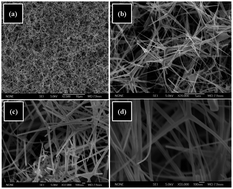Rapid microwave synthesis of high aspect-ratio ZnO nanotetrapods for swift bisphenol A detection†
Abstract
Highly crystalline and high aspect-ratio ZnO nanotetrapods were grown by a novel and swift microwave synthesis.

Maintenance work is planned for Wednesday 1st May 2024 from 9:00am to 11:00am (BST).
During this time, the performance of our website may be affected - searches may run slowly and some pages may be temporarily unavailable. If this happens, please try refreshing your web browser or try waiting two to three minutes before trying again.
We apologise for any inconvenience this might cause and thank you for your patience.
* Corresponding authors
a
Center of Research Excellence in Nanotechnology and Department of Chemistry, King Fahd University of Petroleum & Minerals, Dhahran 31261, Saudi Arabia
E-mail:
ahsanulhaq@kfupm.edu.sa
Tel: +966-03-860-7063
b University of Antwerp, Department of Chemistry, Groenenborgerlaan, 171, Antwerp, Belgium
c Department of Physics, Center of Research Excellence in Nanotechnology, King Fahd University of Petroleum & Minerals, Dhahran 31261, Saudi Arabia
Highly crystalline and high aspect-ratio ZnO nanotetrapods were grown by a novel and swift microwave synthesis.

 Please wait while we load your content...
Something went wrong. Try again?
Please wait while we load your content...
Something went wrong. Try again?
A. Qurashi, J. A. Rather, K. De Wael, B. Merzougui, N. Tabet and M. Faiz, Analyst, 2013, 138, 4764 DOI: 10.1039/C3AN00336A
To request permission to reproduce material from this article, please go to the Copyright Clearance Center request page.
If you are an author contributing to an RSC publication, you do not need to request permission provided correct acknowledgement is given.
If you are the author of this article, you do not need to request permission to reproduce figures and diagrams provided correct acknowledgement is given. If you want to reproduce the whole article in a third-party publication (excluding your thesis/dissertation for which permission is not required) please go to the Copyright Clearance Center request page.
Read more about how to correctly acknowledge RSC content.
 Fetching data from CrossRef.
Fetching data from CrossRef.
This may take some time to load.
Loading related content
